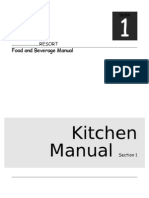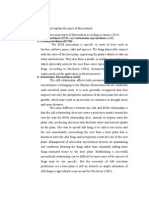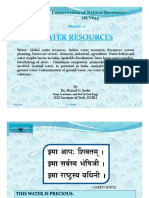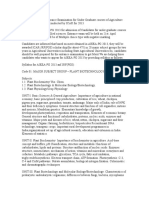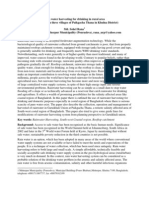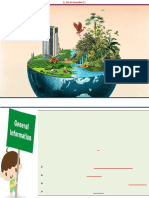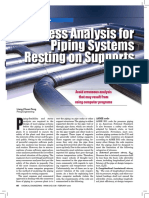Difference Between Organic Farming and Chemical Farming - Subhashri Bio Energies
Difference Between Organic Farming and Chemical Farming - Subhashri Bio Energies
Uploaded by
Śáńtőśh MőkáśhíCopyright:
Available Formats
Difference Between Organic Farming and Chemical Farming - Subhashri Bio Energies
Difference Between Organic Farming and Chemical Farming - Subhashri Bio Energies
Uploaded by
Śáńtőśh MőkáśhíOriginal Description:
Copyright
Available Formats
Share this document
Did you find this document useful?
Is this content inappropriate?
Copyright:
Available Formats
Difference Between Organic Farming and Chemical Farming - Subhashri Bio Energies
Difference Between Organic Farming and Chemical Farming - Subhashri Bio Energies
Uploaded by
Śáńtőśh MőkáśhíCopyright:
Available Formats
12/30/13
Difference between organic farming and chemical farming - Subhashri Bio Energies
Chemical Farming
What is it? Cultivation and production (Nutrient, pest & disease management) of crops by inorganic chemical inputs Against Nature In chemically managed soil, the plant nutrients are supplied only through inorganic source, without any organic carbon source to derive food. This ultimately deprives the soil-eco system of the growth medium Blocks The Microbial Activity Due to the absence of carbon source, microbial population trends to be less or sometimes NIL in soil What is it?
Organic Farming
Cultivation and production (Nutrient, pest & disease management) of crops by biodegradable organic inputs Harmony with nature In an organic management, the focus is on food web relations and element cycling aiming to maximize the agro-ecosystem's stability, sustainability and homeostasis (balanced equilibrium) Increases The Microbial Life Organics is the main source for nutrients. The soil microbes derive the food from the carbaneous source and multiply and make the soil lively, also decomposing the complex organic compounds present in the added organics Soil structure improves Stable organic resins (humus) resulting from organic residue decomposition imparts stability to soil aggregates and corrects the permeability i.e., crumb like structure. This structure facilitates to improve soil aeration, water holding capacity, root penetration, while reducing the soil erosion by b aggregation of soil particles Soils become fertile Here the biological property of the soil is improved by addition of organic manure. Intensive biological activity promotes better symbiotic relationship between plant and the soil focusing on sustainable plant production and nutrient management. Buffering of soils (Enables neutral pH) Presence of colloidal matter improves the buffering capacity of the soil and Cation Exchanging Capacity. It regulates the nutrient availability due to buffering action, besides checking the toxicity levels to plants and soil microbes Nutrients available for longer period Microbes decompose the complex organic compounds to mineral components and CO2. Further the mineral elements are converted in to available plant nutrients through mineralization process. These ions are held by organic matter and soil colloids and are slowly released as nutrients over a longer period. Prevents the soil erosion Organic soil management techniques such as organic fertilization, mulching and cover cropping increases aggregation (by organic acid), improves soil structure and therefore increase the soil's water infiltration and retention capacity, substantially reducing the risk of erosion There is no hazardous material in soil It doesnt leave any residues/ hazardous material in the soil since all input is biodegradable & non-toxic
1/2
Soil structure is destroyed Non-availability of binding material of the soil particles result in disintegration and reduce the soil granulation. In the long run it may reduce the productive capacity of land to harbor the crops & become unfit for production
Soil becomes dead While chemical farming satisfies only the crop nutrient requirements, it is not conducive for biological environment of the soil, finally resulting in a problematic soil loaded with inorganic salts Alters the soil pH Continuous use of inorganic chemicals leads to changes in the pH of the soil (either acidic or saline depending on the type of fertilizer used). It unbalances the nutrient availability status and in some cases creates toxicity to the plants Nutrients are available only for shorter period Certain fertilizers in the absence of microbes permanently fix on to the soil particles and may not be available for plant root absorption. In addition, the chemical fertilizers are easily water soluble and this may lead to various types of losses through leaching, evaporation, etc. Leads to erosion Absence of binding agents (organic substances) between soil particles makes the soil particles to be easily detached by water and wind. It leads to loss of top fertile soils ultimately making the land barren and unfit for farming/cultivation Accumulation of hazardous material in soil Over and abuse of chemical fertilizers (nitrate) & pesticides harm the biological life of the soil. The residues such as
www.pso6.com/difference.html
You might also like
- MAN 2842 E Industrial Gas Engine Repair ManualDocument120 pagesMAN 2842 E Industrial Gas Engine Repair ManualLaurent Grunewald50% (2)
- Affidavit of Non Filing of Income TaxDocument3 pagesAffidavit of Non Filing of Income TaxAbram IsabeloNo ratings yet
- 10.04 Kitchen Hygiene Manual Section 1,2,3 60pDocument61 pages10.04 Kitchen Hygiene Manual Section 1,2,3 60porientalhospitality88% (16)
- Impact of Online Food Delivery On The Financial Performance of Rwandan Restaurant IndustryDocument65 pagesImpact of Online Food Delivery On The Financial Performance of Rwandan Restaurant Industryndayishimiye innocent100% (1)
- Questions and Answers About MycorrhizaDocument8 pagesQuestions and Answers About MycorrhizaEpiscia Atfal LintangNo ratings yet
- Renewable and Non Renewable ResourcesDocument14 pagesRenewable and Non Renewable ResourcesSittie Ainie100% (1)
- Biofertilizer Questions AnsDocument12 pagesBiofertilizer Questions Anskhairul islam nobinNo ratings yet
- Chemistry Project JIGNASA 21-22Document10 pagesChemistry Project JIGNASA 21-22Ramya RajeshNo ratings yet
- Question Bank - Biodiversity Governance ModelsDocument3 pagesQuestion Bank - Biodiversity Governance ModelsSugandha ShetyeNo ratings yet
- Power Point ProjectDocument51 pagesPower Point ProjectParthiv AnilNo ratings yet
- Environmental Studies - Question Bank Multidisciplinary Nature of Environmental StudiesDocument6 pagesEnvironmental Studies - Question Bank Multidisciplinary Nature of Environmental StudiesAditya KapoorNo ratings yet
- Apm 821Document1 pageApm 821Vignesh RamNo ratings yet
- Conservation Agriculture by AnuragDocument17 pagesConservation Agriculture by AnuragAnurag Shankar SinghNo ratings yet
- Environmental Studies Assignment PDFDocument15 pagesEnvironmental Studies Assignment PDFAayush UpadhyayNo ratings yet
- Food ResourcesDocument20 pagesFood ResourceshiranNo ratings yet
- Organic Farming Envs Project Sovan Maity Sovan MaityDocument11 pagesOrganic Farming Envs Project Sovan Maity Sovan Maityzahabiya mithiborwalaNo ratings yet
- Introduction To EVSDocument41 pagesIntroduction To EVSsoumyajeetkundu123No ratings yet
- Natural Resources - Module 2 - ppt1Document17 pagesNatural Resources - Module 2 - ppt1Appasabgouda Biradar100% (1)
- Unit V - Economic Botany NotesDocument9 pagesUnit V - Economic Botany NotesJayanthi PNo ratings yet
- Shone Organic Farming IIDocument15 pagesShone Organic Farming IIShone Philips ThomasNo ratings yet
- SBT B309 - Advanced Plant Ecology - 2020Document39 pagesSBT B309 - Advanced Plant Ecology - 2020Stellamaris MutukuNo ratings yet
- Environmental NotesDocument18 pagesEnvironmental NotesShridhar NaganeNo ratings yet
- Xii - 2022-23 - Biology - RaipurDocument219 pagesXii - 2022-23 - Biology - Raipursuresh babu0% (1)
- 3 Soil Mapping and Fertilizer Recommendation Using Geospatial TechnologiesDocument3 pages3 Soil Mapping and Fertilizer Recommendation Using Geospatial TechnologiesPRAMOD KUMARNo ratings yet
- Soil Taxonomy - Advantages, Surface Diagnostic HorizonsDocument7 pagesSoil Taxonomy - Advantages, Surface Diagnostic HorizonsshubhamNo ratings yet
- Bray NutrientMobilityDocument2 pagesBray NutrientMobilityanamika1180No ratings yet
- Soil Organic Matter PDFDocument13 pagesSoil Organic Matter PDFBishwaksen BaidyaNo ratings yet
- Contingency Crop Planning NewDocument3 pagesContingency Crop Planning Newatul211988100% (1)
- Effect of Different Levels of Potassium and Boron On Growth, Yield and Quality of Carrot (Daucus Carota Cv. New Kuroda) in Nawalparasi, NepalDocument8 pagesEffect of Different Levels of Potassium and Boron On Growth, Yield and Quality of Carrot (Daucus Carota Cv. New Kuroda) in Nawalparasi, NepalInternational Journal of Innovative Science and Research TechnologyNo ratings yet
- UNIT-I (Sem-I) EVS - Environment & EcosystemDocument16 pagesUNIT-I (Sem-I) EVS - Environment & Ecosystemwalid ben aliNo ratings yet
- Design and Development of Low Cost Greenhouse To Raise Different Cultivars"Document9 pagesDesign and Development of Low Cost Greenhouse To Raise Different Cultivars"Anonymous ELujOV3No ratings yet
- Evs Project Biodiversity PDFDocument2 pagesEvs Project Biodiversity PDFBrittany36% (11)
- Disease Suppression by Mycorrhizal FungiDocument68 pagesDisease Suppression by Mycorrhizal FungiMuhammad MushtaqNo ratings yet
- Project Report On Manures and Chemical FertilizersDocument13 pagesProject Report On Manures and Chemical FertilizerssusmaNo ratings yet
- Environmental Studies Question BankDocument30 pagesEnvironmental Studies Question BankmarigoldbloomsNo ratings yet
- Agroforestry and Social Forestry: 5. Silvi-Agriculture Refers ToDocument17 pagesAgroforestry and Social Forestry: 5. Silvi-Agriculture Refers ToVaseem Raza Mirza100% (2)
- Rangeland Soil Quality-Soil BiotaDocument2 pagesRangeland Soil Quality-Soil BiotaeraNo ratings yet
- Horticultural Terms and DefinitionsDocument166 pagesHorticultural Terms and Definitions01sec 062No ratings yet
- Soil Microbiology Intro PDFDocument32 pagesSoil Microbiology Intro PDFSudeeksha Ravikoti100% (1)
- NANOTECHNOLOGY SeminarDocument30 pagesNANOTECHNOLOGY SeminarArvind Singh KasanaNo ratings yet
- New Syllabus ICAR JRFDocument22 pagesNew Syllabus ICAR JRFMechanical EngineeringNo ratings yet
- MCQ-LD AmsDocument16 pagesMCQ-LD AmsASWIN KUMAR N SNo ratings yet
- Economic Importance of BryophytesDocument11 pagesEconomic Importance of BryophytesaigilNo ratings yet
- ENVIRONMENTAL MOVEMENTS IN INDIA FC ProjectDocument10 pagesENVIRONMENTAL MOVEMENTS IN INDIA FC Projectgayatri panjwaniNo ratings yet
- Edaphic FactorDocument16 pagesEdaphic FactorHarshitha RameshNo ratings yet
- Environment Ecology BYJU Notes (Shashidthakur23.Wordpress - Com)Document22 pagesEnvironment Ecology BYJU Notes (Shashidthakur23.Wordpress - Com)Amal JoseNo ratings yet
- Winter School Cum Training (NATURE-2024)Document16 pagesWinter School Cum Training (NATURE-2024)lixpix30No ratings yet
- Agri-Informatics and Introduction To ComputerDocument13 pagesAgri-Informatics and Introduction To Computernsfwking069No ratings yet
- Soil Science and EngineeringDocument4 pagesSoil Science and EngineeringRockers Arul100% (1)
- Project Concept Note On Organic Vegetable Cultivation in Chitwan DistrictDocument14 pagesProject Concept Note On Organic Vegetable Cultivation in Chitwan DistrictRedwan100% (1)
- DR S P Singh-Drudgery Reducing Farm EquipmentDocument26 pagesDR S P Singh-Drudgery Reducing Farm Equipmentapi-200677911No ratings yet
- Plant eCOLOGY PDFDocument79 pagesPlant eCOLOGY PDFFarhadullah KhanNo ratings yet
- Waste Water Reuse in AgricultureDocument14 pagesWaste Water Reuse in Agriculturegulshan araNo ratings yet
- Agriculture ReportDocument8 pagesAgriculture Reportswayambhu000No ratings yet
- Esdm 231Document30 pagesEsdm 231Priyanka Mestri100% (1)
- Field Visit & Pracvtical Report at Nitttr Chandigarh PDFDocument29 pagesField Visit & Pracvtical Report at Nitttr Chandigarh PDFAnonymous rQscGldapDNo ratings yet
- 1.1. Status of Organic Farming in IndiaDocument42 pages1.1. Status of Organic Farming in IndiaVipul SharmaNo ratings yet
- " ": Rainwater HarvestingDocument15 pages" ": Rainwater HarvestingLucifer100% (1)
- Sustainable Agriculture: BY: Naiya Bba Vi 111Document22 pagesSustainable Agriculture: BY: Naiya Bba Vi 111Salil KatyalNo ratings yet
- Bangladesh Rain Water Harvesting For Drinking in Rural Area: A Case Study On Three Villages of Paikgacha Thana in Khulna DistrictDocument11 pagesBangladesh Rain Water Harvesting For Drinking in Rural Area: A Case Study On Three Villages of Paikgacha Thana in Khulna DistrictFree Rain Garden Manuals100% (1)
- Cs 1.2 Case Study: Land Reclamation Project IN Uttar PradeshDocument30 pagesCs 1.2 Case Study: Land Reclamation Project IN Uttar PradeshSophia ChinNo ratings yet
- Class 1 23.09.2024 EVS&EWM (BCS508)Document50 pagesClass 1 23.09.2024 EVS&EWM (BCS508)Sathish YA100% (1)
- Principles of Integrated Pest and Disease Management: Department of Plant Pathology, LPUDocument28 pagesPrinciples of Integrated Pest and Disease Management: Department of Plant Pathology, LPUYaiphabaNo ratings yet
- Differences Between Chemical Farming and Organic FarmingDocument4 pagesDifferences Between Chemical Farming and Organic FarmingRahul N Shripati100% (2)
- Corruption Is One of The Biggest Threat ToDocument2 pagesCorruption Is One of The Biggest Threat ToŚáńtőśh MőkáśhíNo ratings yet
- MCGM PF SlipDocument2 pagesMCGM PF SlipŚáńtőśh Mőkáśhí75% (4)
- Display Raj PatraDocument2 pagesDisplay Raj PatraŚáńtőśh MőkáśhíNo ratings yet
- Swami Vivekananda: Bengali: BengaliDocument1 pageSwami Vivekananda: Bengali: BengaliŚáńtőśh MőkáśhíNo ratings yet
- Group 4Document34 pagesGroup 4Śáńtőśh MőkáśhíNo ratings yet
- Badminton: Cleanliness SloganDocument3 pagesBadminton: Cleanliness SloganŚáńtőśh MőkáśhíNo ratings yet
- To Do On Daily Basis: MccafeDocument1 pageTo Do On Daily Basis: MccafeŚáńtőśh MőkáśhíNo ratings yet
- The India of My DreamsDocument1 pageThe India of My DreamsŚáńtőśh MőkáśhíNo ratings yet
- Water Supply and Sanitation: Railway Advantages: 1. DependableDocument2 pagesWater Supply and Sanitation: Railway Advantages: 1. DependableŚáńtőśh MőkáśhíNo ratings yet
- Car Revese HornDocument8 pagesCar Revese HornŚáńtőśh MőkáśhíNo ratings yet
- Curriculum Vitae: Sushant Suresh VajeDocument3 pagesCurriculum Vitae: Sushant Suresh VajeŚáńtőśh MőkáśhíNo ratings yet
- Curriculum Vitae: Personal ProfileDocument2 pagesCurriculum Vitae: Personal ProfileŚáńtőśh MőkáśhíNo ratings yet
- Rohan Dilip Milkhe: Residential & Permanent AddressDocument2 pagesRohan Dilip Milkhe: Residential & Permanent AddressŚáńtőśh MőkáśhíNo ratings yet
- App 27802794462079Document2 pagesApp 27802794462079Śáńtőśh MőkáśhíNo ratings yet
- Curriculum Vitae: Personal ProfileDocument2 pagesCurriculum Vitae: Personal ProfileŚáńtőśh MőkáśhíNo ratings yet
- Seasonal Goods DemandDocument45 pagesSeasonal Goods DemandŚáńtőśh MőkáśhíNo ratings yet
- Government of India Nuclear Recycle Board Bhabha Atomic Research Centre Personnel Division A N - 01/2016 (R-I)Document7 pagesGovernment of India Nuclear Recycle Board Bhabha Atomic Research Centre Personnel Division A N - 01/2016 (R-I)Śáńtőśh MőkáśhíNo ratings yet
- Shivaji MaharajDocument2 pagesShivaji MaharajŚáńtőśh MőkáśhíNo ratings yet
- Baithe KhelDocument1 pageBaithe KhelŚáńtőśh MőkáśhíNo ratings yet
- Philip SerraoDocument1 pagePhilip SerraoŚáńtőśh MőkáśhíNo ratings yet
- 92 63Document1,531 pages92 63Śáńtőśh MőkáśhíNo ratings yet
- Mobile Phone Radiation: Analysis of DataDocument2 pagesMobile Phone Radiation: Analysis of DataŚáńtőśh MőkáśhíNo ratings yet
- Finding and AnalysisDocument4 pagesFinding and AnalysisŚáńtőśh MőkáśhíNo ratings yet
- CT For Protection: Prof.O.V.Gnana SwathikaDocument24 pagesCT For Protection: Prof.O.V.Gnana SwathikaSarthak VatsNo ratings yet
- tình huống jurnalDocument340 pagestình huống jurnalHera Tri UtomoNo ratings yet
- 5Document8 pages5LEGIONERNo ratings yet
- Business Studies: Question Bank Term-II 2021-22Document58 pagesBusiness Studies: Question Bank Term-II 2021-22sameeksha kosariaNo ratings yet
- Medici Di Makati College A.Y. 2019-2020: in Partial Fulfilment of The Requirements in Science, Technology, and SocietyDocument9 pagesMedici Di Makati College A.Y. 2019-2020: in Partial Fulfilment of The Requirements in Science, Technology, and SocietyDenise VillanuevaNo ratings yet
- Transportation System ComprehensionDocument4 pagesTransportation System ComprehensionClarence Dave TolentinoNo ratings yet
- Outcome-Based Assessment-1Document5 pagesOutcome-Based Assessment-1Ryan Neil CajucomNo ratings yet
- Huawei Tds Sun2000-330ktl-H1 enDocument2 pagesHuawei Tds Sun2000-330ktl-H1 enMuhammad Ali HaiderNo ratings yet
- Permanent Mold CastingDocument3 pagesPermanent Mold CastingNirav patelNo ratings yet
- Lab ManualDocument4 pagesLab ManualMaha Lakshmi ShankarNo ratings yet
- Decide To Lead Building Capacity and LeveragingDocument107 pagesDecide To Lead Building Capacity and Leveragingpumas cuNo ratings yet
- Analisis de Stress en TuberíasDocument4 pagesAnalisis de Stress en TuberíasJanneth Herrera Flores100% (1)
- As 400 Interview QuestionDocument48 pagesAs 400 Interview QuestionpokirishivaaaNo ratings yet
- BOQ - Zallaf South Refinery Project - CAMP & TSFDocument18 pagesBOQ - Zallaf South Refinery Project - CAMP & TSFtmtg1983No ratings yet
- Lom LogDocument33 pagesLom LogJeon “SoyeonG” yoonieNo ratings yet
- Department: FUTURES & OPTIONS: Trading Holidays For The Calendar Year 2019Document2 pagesDepartment: FUTURES & OPTIONS: Trading Holidays For The Calendar Year 2019kishore SIMHANo ratings yet
- Database NotesDocument31 pagesDatabase NotesSaad QaisarNo ratings yet
- Advt PP 020514Document4 pagesAdvt PP 020514Senthilkumar VNo ratings yet
- General Specification For Visual TestingDocument5 pagesGeneral Specification For Visual Testingsyukron_a100% (1)
- End of Semester One Examinations 2003/2004Document5 pagesEnd of Semester One Examinations 2003/2004Tess JackNo ratings yet
- Section A Section A Consists of 7 Questions (1-7), Each Question Carries 2 MarksDocument5 pagesSection A Section A Consists of 7 Questions (1-7), Each Question Carries 2 Marksavi jitNo ratings yet
- Shore Base Maintenance Kapal ROYAL KING ALIDocument3 pagesShore Base Maintenance Kapal ROYAL KING ALIGilang Ramadhan100% (1)
- What Happened Till The First Supply 1Document10 pagesWhat Happened Till The First Supply 1Omega. editss (omega.editss)No ratings yet
- Chitendai LTD Iradiance Vs Silicon Solar PanelDocument4 pagesChitendai LTD Iradiance Vs Silicon Solar PanelRamon CuevasNo ratings yet
- Globe Life - AIL - Spotlight Magazine - 2021-11Document27 pagesGlobe Life - AIL - Spotlight Magazine - 2021-11Fuzzy PandaNo ratings yet
- Document 114Document47 pagesDocument 114sreejaps45No ratings yet


